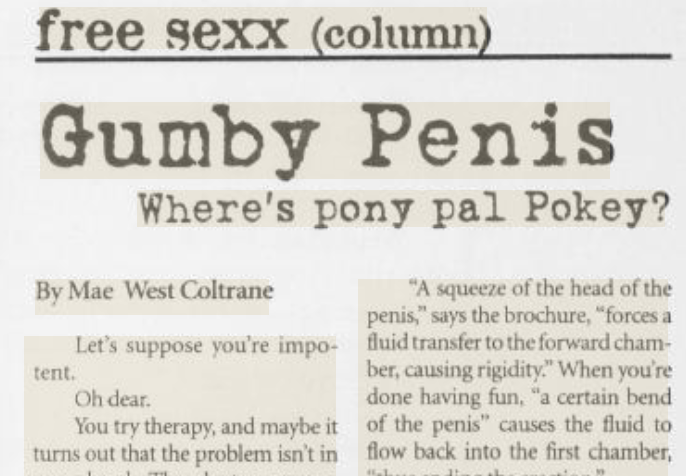Second to having actual sex, talking about sex is one of the most important rituals of university life. Fizz, of course, is always seething with sexual posts, and for many years in The Stanford Daily’s history, the Arts & Life section, too, devoted itself to this noble task of discussing sex.
Throughout the ’90s, a column called “sexx” ran in the back cover of Intermission, a separate weekly issue that covered Arts & Life content for the Daily. The column, written under the pseudonyms Roxy Sass and Mae West Coltrane, featured articles, advice, interviews and comics all about copulation.
The articles were nothing short of adventurous. In one piece, Roxy Sass recommended nicking chocolate sauce from FloMo dining to add some extra flavor to lovemaking. One could even incorporate the fur of a kiwi or the spikes of a horned melon if one was feeling especially frisky.
Sass-Coltrane often found herself reporting back from strange locales, like San Francisco sex clubs and swinging parties, or interviewing fascinating figures, like dominatrixes and phone sex operators. Retelling a story from the phone sex operator, she wrote that a client had apparently paid the operator to describe him penetrating a block of cheese. And two separate columns were written extolling the virtues of genital piercings.
Beyond some of the more eye-catching stories, the column was also full of practical advice. Sass-Coltrane encouraged her readers to get tested for AIDS and informed them on STD prevention. There were guides to finding the female g-spot and the male anal g-spot, as well as a very detailed and thorough introduction to anal sex, complete with advice for strap-ons.
And still in the realm of practical, but slightly more offbeat, was the question of what to do if one was impotent. Some of Mae West Coltrane’s suggestions were semi-rigid rods one could insert into the penis, a penis pump or a “Vacuum Erection Device.”
Even if one has no investment in reading about sex, the “sexx” columns are worth rifling through just for the sheer pleasure of reading itself. The writers behind “sexx” perfected the witty, sardonic personas of Sass-Coltrane. When advising about the workplace ethics for student-TA relationships, Roxy Sass warned: “Going at it full-steam on the table before section starts is not such a great idea, especially if your section contains that one freshman who still thinks he or she needs to arrive five minutes early to ‘prepare’ for section.” And in a column discussing the benefits of entering an orgiastic polycule with one’s friend group, Roxy Sass observed rather sharply that “[i]t would certainly save you all the time you would have spent gossiping about who got together with whom last Saturday night.”
One of Roxy Sass’s best lines came from her wisdom to not fake the female orgasm: “Faking orgasms is like baking a cake with salt instead of sugar. It looks appealing superficially, but when you get into it, you find a world of bitterness.”
The “sexx” columns were fun and frank, filled with an openness towards all the unexplored horizons of sex. Sex is sacred, as is the sheer pleasure of just talking about it afterwards. Though Arts & Life eventually transitioned to more objective, reporting-focused content, this column reflects The Stanford Daily’s historical take of sex as an act that needed to be normalized and discussed openly.
Editor’s Note: This article is a review and includes subjective thoughts, opinions and critiques.
